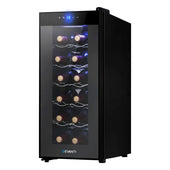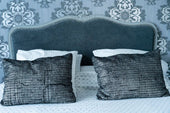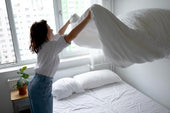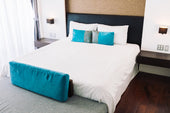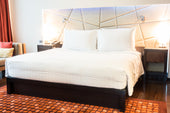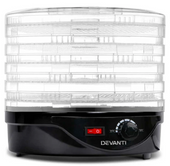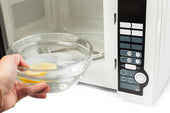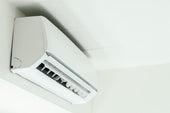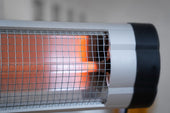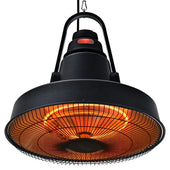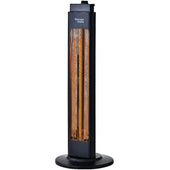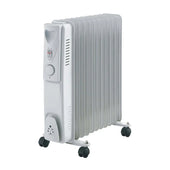Understanding the Role of Bedside Tables in Sleep Psychology
Bedside tables influence sleep psychology by creating a sense of order and familiarity. A clutter-free, well-organised bedside table can help reduce visual stress, promoting mental relaxation before sleep. Items kept on the table, such as a lamp or a favourite book, serve as comforting cues that signal bedtime rituals, aiding in sleep association.
The positioning and height of the bedside table also play a role in accessibility and convenience, reducing disruptions during the night during days when uninterrupted rest is most needed. Additionally, soft lighting and personal touches such as calming décor can contribute to creating a soothing atmosphere, positively impacting sleep quality and psychological comfort.
The Connection Between Sleep Environment and Mental Health
The sleep environment significantly impacts mental health by influencing relaxation and reducing stress levels. Noise, lighting, and room temperature affect sleep quality, which, in turn, impacts emotional well-being. A clutter-free setting promotes calmness and reduces distractions that can heighten anxiety.
Bedside tables contribute to this by allowing organised storage for items like books, journals, or aromatherapy diffusers that aid relaxation. Soft lighting from bedside lamps can create a soothing atmosphere conducive to better sleep. Incorporating personalised touches, such as photos or calming objects, establishes a sense of security, fostering improved mental health.
Designing a Functional and Aesthetic Bedside Table
A bedside table blends utility with style, serving as a personal hub within the sleep environment. Its design should prioritise ergonomics and accessibility, ensuring essential items are within reach without disrupting relaxation. Common elements include a flat top surface for lamps or books and storage options like drawers to minimise clutter. Materials and finishes play a key role, with wood, metal, or glass contributing to aesthetic harmony with the room's decor. The height of the table relative to the bed should be considered, avoiding strain when reaching for objects. Thoughtful organisation maintains order while enhancing visual appeal.
Decluttering Your Bedside Table: Enhancing Focus and Calm
The state of a bedside table can subtly shape the bedroom environment. A cluttered surface often mirrors mental chaos, making it harder to unwind. Removing unnecessary items helps transform the space into a zone of relaxation.
Key steps to declutter include:
- Eliminating Non-Essentials: Limit items to functional or comforting objects like a lamp, clock, or book.
- Introducing Organisers: Small trays or drawers keep essentials tidy and accessible.
- Minimising Decorations: One or two calming elements, such as a candle or plant, add serenity without overwhelming.
A tidy bedside table fosters an ordered, peaceful space, promoting focus and deeper rest.
Optimising Lighting Choices for a Restful Atmosphere
Carefully selected bedside lighting can significantly influence the quality of sleep and relaxation. Dim, warm-coloured lights are ideal as they mimic natural evening light, helping the body prepare for rest. Avoiding bright, cool-toned lights is essential as they may disrupt melatonin production. Consider adjustable light fixtures or three-way bulbs for customisable brightness levels.
Placement is equally important. A soft glow from a lampshade positioned slightly above eye level provides sufficient illumination without creating glare. For a clutter-free bedside table, wall-mounted or pendant lighting options can be both functional and stylish. Furthermore, incorporating smart bulbs allows effortless control over colour and intensity.
The Impact of Colours and Materials on Sleep Quality
The choice of colours and materials in bedside tables can significantly affect the sleep environment. Colours like pastel blue or soft greens are associated with calmness and serenity, promoting relaxation. In contrast, bright or overly dark hues may overstimulate the senses and disrupt rest. Materials also play a key role; natural finishes such as wood convey warmth and grounding, whereas metal or glass can exude a colder, clinical feel. Texture further influences perception—smooth, polished surfaces reflect light, while matte or textured finishes create a softer ambience. Combining these elements thoughtfully can support a more restful sleep atmosphere.
Personalising Your Space: Choosing Items for Comfort and Joy
A bedside table can be transformed into a haven of relaxation and self-expression by incorporating items that bring comfort and joy. Soft lighting can help create a calming ambience; consider choosing a stylish lamp with an adjustable dimmer. Personal touches such as framed photographs or decorative objects add character while connecting the individual with meaningful memories.
Functional yet comforting essentials like books, a journal, or calming aromatherapy diffusers cater to personalised relaxation and mental well-being. Including seasonal or mood-enhancing items, such as candles or small plants, injects a refreshing touch. Prioritising both aesthetic appeal and practical use ensures the bedside table becomes a reassuring and peaceful retreat.
Maintaining Organisation: Creating a Daily Bedside Routine
Incorporating a consistent bedside routine can help maintain organisation and promote better sleep. Establishing this practice ensures that essential items are strategically placed, reducing bedtime stress. Start by designating specific spots on the bedside table for necessities such as a lamp, a water glass, or reading materials.
To maintain order:
- Declutter regularly: Clear away unnecessary items daily.
- Use organisers: Small trays or compartments can separate and categorise objects.
- Create a wind-down ritual: Include actions like placing your phone on silent mode or journaling.
Consistency fosters habits, enabling the table to remain neat. Such routines also create mental associations with relaxation and rest.
The Science Behind Minimalism for Better Sleep
Minimalism in a bedroom environment fosters better sleep by reducing cognitive and visual stimuli. Cluttered spaces can trigger stress and anxiety, which negatively impact sleep quality. Research suggests that a clean and simplified bedside table, free from distractions, supports a more restful state by promoting mental clarity.
Key environmental factors linked to improved sleep include:
- Minimalistic design: Fewer items create a calming atmosphere.
- Organised surroundings: Order reduces decision fatigue and mental load.
- Muted colour palette: Neutral tones contribute to soothing the mind.
A minimalist bedside table limits potential disruptions, helping the brain associate the space with relaxation rather than activity.
Hidden Dangers: Avoiding Overstimulation from Electronics
Devices such as smartphones, tablets, and laptops can disrupt sleep patterns by emitting blue light that interferes with melatonin production. Limiting electronic usage near bedtime promotes better rest. Proximity to these devices can also foster a reliance on them for entertainment, leading to overstimulation and delayed sleep onset.
Tips to Minimise Electronics' Impact
- Turn off devices one hour before bedtime.
- Use blue light filters to reduce eye strain.
- Keep gadgets out of reach, preferably outside the bedroom.
- Switch to analogue alternatives, such as books or journaling, for evening activities.
Physical clutter of electronics on bedside tables contributes to a restless environment, so their placement demands consideration.
The Bedside Table as a Reflection of Your Inner World
A bedside table can act as a window into a person’s inner self, revealing their priorities, habits, and emotional state. The objects placed on or within it—whether books, photographs, or technology—speak volumes about an individual’s mindset. For example:
- Books or Journals: Indicate intellectual curiosity or a reflective nature.
- Minimalist Setup: Suggests a preference for simplicity and organisation.
- Cluttered Items: Could point to stress or a busy lifestyle.
- Sentimental Keepsakes: Highlight emotional attachment and nostalgia.
What a person keeps within reach often reveals subconscious needs and values. This interplay between the physical and psychological underscores the bedside table’s role in reflecting one’s inner world.
Practical Tips for Balancing Style and Functionality
- Choose Proportions Wisely: Select a bedside table proportional to the bed size. Oversized tables can crowd the space, while undersized ones may limit functionality.
- Prioritise Storage Needs: For added convenience, opt for tables with drawers or shelves to keep essential items organised and reduce clutter.
- Incorporate Lighting: Include a compact bedside lamp or mounted lighting to ensure practical illumination for reading or relaxation.
- Coordinate Design Elements: Match the bedside table’s colour and finish with the room’s décor to create a cohesive aesthetic.
- Opt for Multi-functional Designs: Consider bedside tables with built-in charging ports or pull-out trays to combine style with utility effectively.















